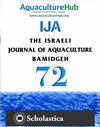The involvement of GSK3β for glycogen synthesis throughout the annual cycle of Pacific oyster, Crassostrea gigas (Magallana gigas)
IF 0.5
4区 农林科学
Q4 FISHERIES
引用次数: 0
Abstract
Crassostrea gigas is a frequently studied species in understanding physiological processes in bivalves. Similar to other animals, oysters store glucose in the body as glycogen. Glycogen is known to supply energy for germ cell development and maintenance. Glycogen is synthesized by glycogen synthase. GSK3β regulates glycogen synthase activity and plays an important role in glycogen synthesis. Therefore, this study aims to examine the effect of GSK3β on the annual cycle of oysters and the glycogen synthesis pathway and to investigate the energy pathway in comparison with seasonal variation. Oysters were sampled monthly for one year and were subjected to glycogen content, RT-PCR, FISH, and western blot analysis. The year-round glycogen content significantly differs only in the mantle edge during spring and summer of both sexes but not in labial palp, digestive gland, gonad, and adductor muscle. The expression of GSK3β mRNA level was highest in October for females and April for males. Both sexes had the lowest expression in July. In the adductor muscle, females and males showed the highest expression in April and the lowest in July and October. The pattern of GSK3β expression in gonads and adductor muscle was similarly confirmed through FISH. As a result of examining the signaling system, p-GSK3β (serine 9) increased. At the same time, glycogen synthase decreased in May when the condition index was the highest, p-GSK3β decreased in October and July when spawning occurred, and glycogen synthase increased. Overall, it is thought that p-GSK3β expression is high in C. gigas at ripe, which inhibits glycogen synthesis and is used as energy for growth and maturation. Glycogen synthesis occurs for energy storage during degeneration.GSK3β在太平洋牡蛎(长牡蛎)年循环中参与糖原合成
长牡蛎是了解双壳类动物生理过程中经常被研究的物种。和其他动物一样,牡蛎把葡萄糖以糖原的形式储存在体内。糖原为生殖细胞的发育和维持提供能量。糖原是由糖原合成酶合成的。GSK3β调节糖原合成酶活性,在糖原合成中起重要作用。因此,本研究旨在研究GSK3β对牡蛎年周期和糖原合成途径的影响,并通过季节变化研究能量途径。牡蛎每月取样一年,进行糖原含量、RT-PCR、FISH和western blot分析。全年糖原含量仅在春夏两季两性衣壳边缘有显著差异,而在唇掌、消化腺、性腺和内收肌中无显著差异。GSK3β mRNA的表达量在雌性10月和雄性4月最高。两性在7月份的表达量最低。内收肌中,男女在4月表达量最高,在7月和10月表达量最低。GSK3β在性腺和内收肌中的表达模式同样通过FISH得到证实。作为检测信号系统的结果,p-GSK3β(丝氨酸9)增加。同时,糖原合成酶在条件指数最高的5月下降,p-GSK3β在产卵发生的10月和7月下降,糖原合成酶升高。总的来说,我们认为p-GSK3β在C. gigas成熟时表达量很高,这抑制了糖原的合成,并被用作生长和成熟的能量。糖原合成是为了在变性过程中储存能量。
本文章由计算机程序翻译,如有差异,请以英文原文为准。
求助全文
约1分钟内获得全文
求助全文
来源期刊
CiteScore
0.90
自引率
16.70%
发文量
49
审稿时长
3 months
期刊介绍:
Information not localized

 求助内容:
求助内容: 应助结果提醒方式:
应助结果提醒方式:


